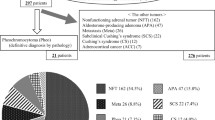Abstract
Background
Screening tests for pheochromocytoma involve measuring levels of catecholamines in the urine or plasma, which have significant false-positive rates. We reviewed patients with adrenal masses and elevated levels of catecholamines to determine the value of different preoperative tests in diagnosing pheochromocytomas.
Methods
A retrospective chart review identified patients who underwent adrenalectomy between 1997 and 2011 with elevation of urine or serum catecholamines. A database of clinicopathologic factors was created including preoperative urine and plasma metanephrines, normetanephrines, vanillylmandelic acid, and fractionated catecholamines, and tumor dimensions on imaging and pathology.
Results
A total of 70 patients underwent adrenalectomy because of presence of an adrenal mass and elevation of catecholamines or normetanephrines or metanephrines. Of these, 46 had pathologically confirmed pheochromocytomas. To improve our ability to discriminate between pheochromocytoma and other pathology, we examined different combinations of clinicopathologic factors and catecholamine levels and found the best test was a scoring system. Points are awarded for a hierarchy of elevated normetanephrine, norepinephrine, metanephrines, with additional points received for age <50 and size on imaging >3.3 cm. A score of 2 is suggestive of pheochromocytoma, with a positive predictive value of 86–87 %, while a score of 4 is diagnostic with positive predictive value of 100 %.
Conclusion
We found that urine/serum normetanephrine levels were the most valuable screening tool; however, a score examining the size of adrenal mass on preoperative CT, age, and either plasma or urine norepinephrine, metanephrine, and normetanephrine values leads to a higher positive predictive value, making this scoring system superior to individual lab tests.

Similar content being viewed by others
References
Beard CM, Sheps SG, Kurland LT, Carney JA, Lie JT. Occurrence of pheochromocytoma in Rochester, Minnesota, 1950 through 1979. Mayo Clin Proc. 1983; 58:802–4.
Manger WM, Gifford RW. Pheochromocytoma. New York: Springer-Verlag; 1977.
Sinclair AM, Isles CG, Brown I, Cameron H, Murray GD, Robertson JW. Secondary hypertension in a blood pressure clinic. Arch Intern Med. 1987; 147:1289–93.
Anderson GH, Jr., Blakeman N, Streeten DH. The effect of age on prevalence of secondary forms of hypertension in 4429 consecutively referred patients. J Hypertens. 1994; 12:609–15.
Young WF, Jr. Management approaches to adrenal incidentalomas. A view from Rochester, Minnesota. Endocrinol Metab Clin North Am. 2000; 29:159–185, x.
Engel A, von EU. Diagnostic value of increased urinary output of pheochromocytoma. Lancet. 1950; 2:387.
Goldenberg M, Serlin I, Edwards T, Rapport MM. Chemical screening methods for the diagnosis of pheochromocytoma. I. Nor-epinephrine and epinephrine in human urine. Am J Med. 1954; 16:310–27.
Lenders JW, Pacak K, Eisenhofer G. New advances in the biochemical diagnosis of pheochromocytoma: moving beyond catecholamines. Ann NY Acad Sci. 2002; 970:29–40.
Mayo CH. Paroxysmal hypertension with tumor of retroperitoneal nerve: report of case. JAMA. 1927; 89:1047–50.
Kvale WF, Manger WM, Priestley JT, Roth GM. Pheochromocytoma. Circulation. 1956; 14:622–30.
Caoili EM, Korobkin M, Francis IR, Cohan RH, Platt JF, Dunnick NR, et al. Adrenal masses: characterization with combined unenhanced and delayed enhanced CT. Radiology. 2002; 222:629–33.
Elsayes KM, Mukundan G, Narra VR, Lewis JS Jr, Shirkhoda A, Farooki A, et al. Adrenal masses: mr imaging features with pathologic correlation. Radiographics. 2004; 24 Suppl 1:S73–86.
Lenders JW, Pacak K, Walther MM, Linehan WM, Mannelli M, Friberg P, et al. Biochemical diagnosis of pheochromocytoma: which test is best? JAMA. 2002; 287:1427–34.
Sawka AM, Jaeschke R, Singh RJ, Young WF, Jr. A comparison of biochemical tests for pheochromocytoma: measurement of fractionated plasma metanephrines compared with the combination of 24-hour urinary metanephrines and catecholamines. J Clin Endocrinol Metab. 2003; 88:553–8.
Hickman PE, Leong M, Chang J, Wilson SR, McWhinney B. Plasma free metanephrines are superior to urine and plasma catecholamines and urine catecholamine metabolites for the investigation of phaeochromocytoma. Pathology. 2009; 41:173–7.
Christensen TT, Frystyk J, Poulsen PL. Comparison of plasma metanephrines measured by a commercial immunoassay and urinary catecholamines in the diagnosis of pheochromocytoma. Scand J Clin Lab Invest. 2011; 71:695–700.
Leung K, Stamm M, Raja A, Low G. Pheochromocytoma: the range of appearances on ultrasound, CT, MRI, and functional imaging. Am J Roentgenol. 2013; 200:370–8.
Baez JC, Jagannathan JP, Krajewski K, O’Regan K, Zukotynski K, Kulke M, et al. Pheochromocytoma and paraganglioma: imaging characteristics. Cancer Imaging. 2012; 12:153–62.
Eisenhofer G, Goldstein DS, Walther MM, Friberg P, Lenders JW, Keiser HR, et al. Biochemical diagnosis of pheochromocytoma: how to distinguish true- from false-positive test results. J Clin Endocrinol Metab. 2003; 88:2656–66.
Messerli FH, Frohlich ED. High blood pressure. A side effect of drugs, poisons, and food. Arch Intern Med. 1979; 139:682–7.
Lenz T, Ross A, Schumm-Draeger P, Schulte KL, Geiger H. Clonidine suppression test revisited. Blood Press. 1998; 7:153–9.
Acknowledgment
Dr. Carr and Dr. Spanheimer were supported by NIH T32 Grant CA148062-01.
Author information
Authors and Affiliations
Corresponding author
Rights and permissions
About this article
Cite this article
Carr, J.C., Spanheimer, P.M., Rajput, M. et al. Discriminating Pheochromocytomas from Other Adrenal Lesions: The Dilemma of Elevated Catecholamines. Ann Surg Oncol 20, 3855–3861 (2013). https://doi.org/10.1245/s10434-013-3142-z
Received:
Published:
Issue Date:
DOI: https://doi.org/10.1245/s10434-013-3142-z




